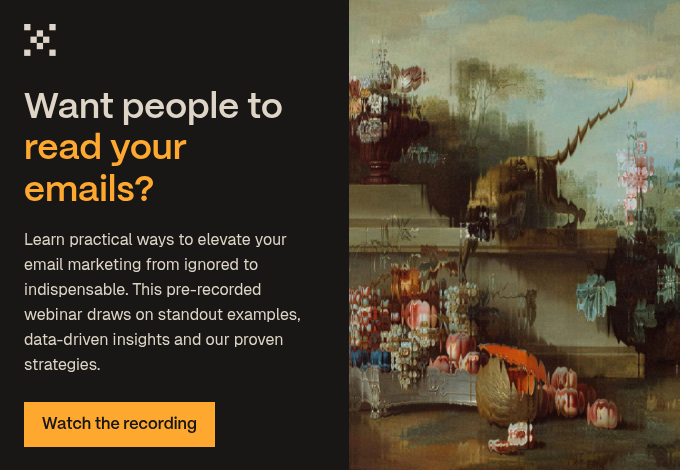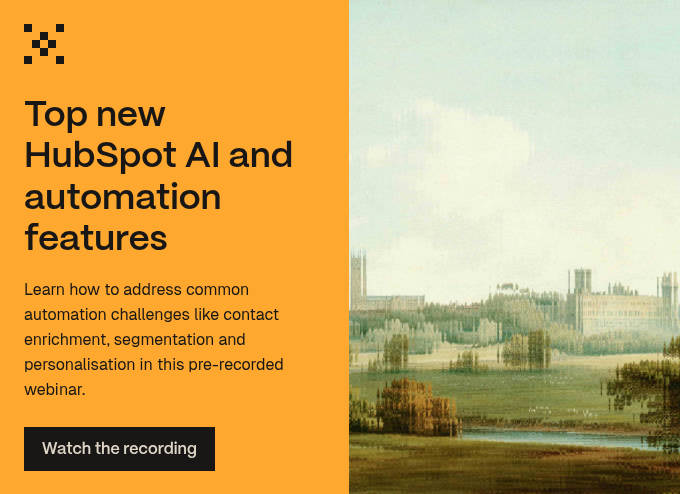Advanced marketing techniques such as Account-based Marketing (ABM) and 1-1 marketing require a more individualised approach than traditional inbound marketing tactics. No longer can we paint with a broad brush, as marketers. We must find ways to speak directly with individuals, rather than an audience.
Personalisation
Personalisation is when you use tracked or provided data to speak directly to individuals, through automation.
Segmentation
Segmentation means targeting activities based on subsections of your audience, using customer data. These activities are sometimes called ‘contextual marketing’.
Let’s start somewhere familiar
You often see the use of personalisation and segmentation in email marketing. Most companies do this.
- For example, they address an email recipient by name using a ‘Name’ field. They can also segment which emails go to certain lists of contacts based on information on their contact record, like job title or sector.
- Another use case is multinational organisations using location ID data to suggest a language change for your site. That way, if a site visitor is visiting from Germany, you can send them to the German version of your website or use a pop-up to suggest they make the switch.
- You could even go so far as to re-prioritise the navigation on your website — based on a cookie being dropped — for known customers. Rather than highlighting your ‘book a demo’ page, instead, you can prioritise portal or platform logins and other content they’d be interested in. Existing customers will have an improved experience, which means they’re more likely to advocate for your brand and give good reviews.
On the flip side, you might have experienced it yourself when companies get personalisation horribly wrong, alienating their audience instead of engaging them.
Something as simple as messing up placeholder default copy or sending the wrong people a highly targeted email can seriously impact your brand reputation. Always have someone double-check your work and your send lists.
OK, so where can segmentation and personalisation be applied beyond the basics?
Account-based marketing (ABM)
We can’t talk about personalisation and segmentation without touching on account-based marketing or ABM.
Despite its roots in a 30-year old concept detailed in Don Peppers and Dr Martha Rogers’ book, ‘The One to One Future: Building Relationships One Customer at a Time’, this is a hot marketing trend, today.
What is ABM?
Unlike inbound marketing, which focuses on individual leads, ABM targets the organisation as a whole. This is a joint effort between Marketing and Sales.
Segment and identify key accounts
Account-based marketing is where you identify key accounts — prospective organisations you want to sell to — by examining specific organisations based on your ICP criteria, emphasis on ‘ideal’. That is, looking at location, revenue, values, size, trajectory, technology, competitors, key stakeholders, buying power and so on. This is not a cursory good-fit check, but a careful data-gathering operation. In this data-driven world, there is a lot you can find out with simple sleuthing and the right digital toolkit.
Agree on your approach
Once you have completed this information-gathering step, marketing and sales should agree on the content and activities that would most entice this specific account, and plan out a cooperative campaign to reel them in.
That might mean social media engagement over time. Subscribing, liking, following, commenting on posts by various team members. Custom one-pagers or reports. Videos made just for that account, emailed directly to each stakeholder with personalised copy. Attending events. Tailored ads and retargeting. Setting up alerts when anyone from this account interacts with marketing materials. You can’t put this kind of effort into every prospect, but for the ideal client, nothing is off-limits.
Get super personal
Where traditional sales is akin to blind speed-dating, ABM is all about making your target organisation feel like ‘the one.’ It’s attentive marketing; paying attention to the specifics. It’s showing you care in a super personal, targeted way.
And it could be setting yourself up for heartbreak. They may not love you back. That kind of sunk cost can be painful to acknowledge — a real blow to the ego. That fact doesn’t get enough acknowledgement. So there is risk, yes, but there is also reward. The potential pay-off is huge. Your biggest deals, your longest partnerships, your best work. The kind of clientele that makes working with your business look like a coveted invitation to the highest echelons of society. You are in demand. You aren’t just another fling, you’re spouse-material.
TL;DR: ABM is where marketing really gets personal.
1-1 marketing
Now for something completely different. With artificial intelligence, the possibilities for personalisation and segmentation are growing.
You can make marketing experiences feel more personal without actually putting in all that ABM-style human effort.
Plus, you can use the pattern-recognising capacity of machine learning to support ABM, in terms of information-gathering. And, even use AI tools to quickly create targeted content for ABM prospects, if you do so with all due diligence. We’re already seeing hyper-targeted ads on social media, with cross-platform data-sharing allowing brands to zero in on your interests. (Hey, if it’s a free platform, then you’re not the customer, as they say.)
‘Personalisation is when you go into a bar and sit down, and the bartender puts a whiskey in front of you without having to ask what you want.’
— Jeff Bezos, founder of Amazon
The reality is, people expect curated experiences. We don’t all have Amazon’s budget, but there are many ways that any business can tailor their brand experience to the individual.
Personalisation and segmentation tactics for 1-1 marketing
- Use behavioural analytics to see which assets on your website may benefit from personalisation. Say, there’s a CTA linking to a landing page that’s popular with a certain demographic of users, such as those that match up with one of your personas.
- Run an A/B test to trial the regular version versus a personalised version. For example, you could have a bit of copy next to your contact form that says ‘Hi [Name], you recently downloaded [offer], which tends to mean you’re interested in [service]. Book a meeting to find out how we can help you with that.’ Or a chatbot that pops up with a message along those same lines.
- Observe. If more people fill in the personalised form or reply to your chatbot, then you’re onto a winner. If not, then maybe you got too personal. Dial it back. Try again. Customers won’t expect loads of personalisation in certain contexts on your website (or elsewhere), so overdoing it will seem like you’ve been going through their bins in your spare time.
(However, don’t mistake what is true now to be true forever. The threshold for personalisation tolerance is already shifting. Younger people, especially, expect a level of personalised marketing and advertising that once would have been off-putting. To quote Marty from Back to the Future, ‘Guess you guys aren’t ready for that yet… but your kids are gonna love it.’)
You can choose to be more subtle about it.
When a new user visits your site and drops a cookie, you can track their touchpoints. So, see if they’ve read half a dozen blog posts about cybersecurity for banks or something. Then, the next time that person lands on the homepage, adjust the copy and even imagery to suit. Instead of the default copy, serve up a banner with a relevant case study in the banking industry or a link to your cybersecurity services. Set up several variants and triggers along various segments.
What is advanced now will be the norm, soon
Yes, this requires a lot of data, a lot of insight and some pretty heavy-duty tools, but we predict it won’t be long before this level of personalisation is the norm for B2B websites.
Today, highly segmented, personalised marketing has the potential to be a real differentiator — but tomorrow? The future of marketing will surely put the custom in ‘customer’.

 Posted by
Maddy Leslie
Posted by
Maddy Leslie





/Medicine.webp?width=400&height=250&name=Medicine.webp)
